3 very simple things you can do to create an eco friendly garden
An eco friendly garden can also save you time and money. So it’s not always just about the principles of sustainability.
I recently spoke to Sally Nex, author of the RHS How to Garden The Low Carbon Way. She says that the first thing we should do is to be more ‘hands off’. ‘We’ve been conditioned – since Victorian times – to think that we’ve always got to be primping and tidying in the garden. We have to wean ourselves off doing too much.’
Sally Nex, author of the RHS How to Garden The Low Carbon Way
This is good news for time-poor gardeners. Put the trowel down. Have a cup of tea. Read How to Garden the Low Carbon Way, published by DK Books. Maybe you won’t have to do that gardening job after all.
Note that links to Amazon are affiliate, see disclosure. Other links are not affiliate.
Why is an eco-friendly garden important?
Urban gardens occupy about 30% of the land in cities and towns. All green growing things hold carbon – the soil, the lawn, the trees and plants. Sally describes even the smallest garden as a ‘tiny carbon sink.’ Add all those tiny carbon sinks together, and you have a carbon sink that occupies 30% of your town or city.
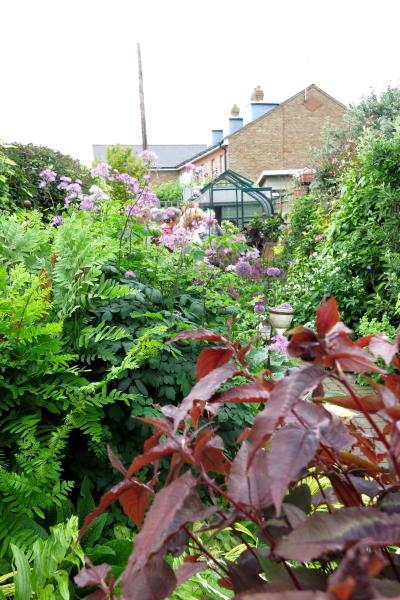
Even a small garden is a carbon sink, especially if it is full of plants.
Public parks and gardens occupy another 30%, by the way, so local authorities have a part to play too.
Plants release oxygen into the air, improving air quality. Areas with soil, lawn or plants absorb rainwater, preventing drains from flash flooding. And tree canopies and climbers shade and insulate buildings, helping to protect them from wind or very hot sun.
Trees and plants also all offer food and habitat to insects and other wildlife, especially those at the bottom of our food chain. If we destroy the bottom of our food chain, we place ourselves ultimately in serious danger. Research from the RHS, Bristol University and others has shown that the nectar from urban gardens offers as much food for pollinators as rural areas do. Moreover, the nectar from urban gardens is more diverse, which means pollinators are less reliant on a single food source. A diverse diet is a healthy one!
Sally says that nobody should feel under pressure to be absolutely environmentally friendly in their garden. ‘Everything we do has an impact, and often just being aware of that impact influences your behaviour. Do what you can.’
Basic eco-friendly garden checklist
This is Sally’s pick of the most important – and easiest – things you can do to make your garden more environmentally friendly. They’re time-saving, too. I’ll explain more about each tip later in the post.
- Put the lawn mower away. Or simply mow the lawn less often – every 2-4 weeks, instead of every week
- Stop digging. The soil stores carbon and every time you expose it to the air, some carbon is released.
- Try to keep your garden waste in your garden if possible, by composting or re-using garden clippings.
- Don’t feel you have to be completely eco-friendly. ‘It’s much better for lots of people to do just a few environmentally friendly things in their gardens than for a few people to do everything perfectly,’ says Sally.
Sustainable gardening tip 1 – put the lawn mower away
Lawns absorb carbon well, so are an important part of the urban ‘carbon sink.’ But Sally explains that the ‘intensive management required for a well-kept lawn’ means a typical lawn absorbs less carbon than it creates. Weekly mowing, especially with a petrol mower, watering and adding fertiliser all use up resources in different ways.
An hour of mowing, she says, ‘spews out as much pollution as a car travelling 93 miles.’
Sally suggests sometimes leaving clippings on the lawn so that the nitrogen breaks down into the lawn and feeds it. That’s certainly an option which means less work, as we won’t have to get rid of the clippings. And it saves money on buying fertiliser.
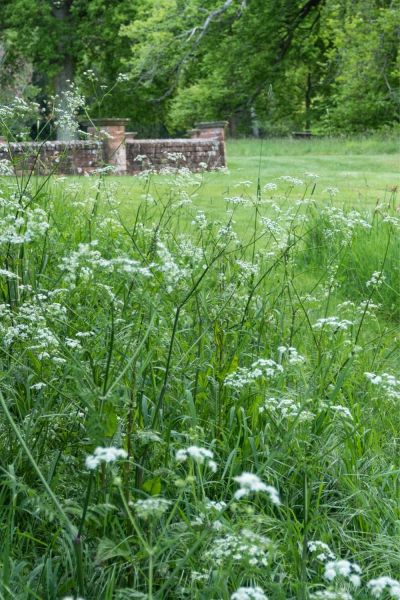
This lawn at Doddington Place Gardens combines different mowing schedules so that some areas are left to grow more wild. This would work in smaller gardens too.
I have taken to putting lawn mowing clippings directly around my potatoes as mulch. It suppresses weeds magnificently, and the potato harvest has been brilliant. And it doesn’t make lawn grass grow on the veg beds because there are no grass seeds in it.
Above all, however, she suggests mowing the lawn less often. That will automatically mean you use less petrol or other energy. It also means that small wildflowers will grow on the lawn, feeding pollinators.
We have mentioned ‘mow less often’ before on the Middlesized Garden in the interview with Jane Moore, author of Planting for Butterflies. After reading it, I suggested mowing every two weeks rather than weekly to Mr Middlesize. As he is the one who actually mows the lawn, he has embraced this philosophy with enthusiasm. In the interests of bio-diversity (or possibly just having some extra free time), he has even let it go three weeks without a trim.
Making ‘mow less often’ work for you
However, it is worth noting that an environmentally friendly lawn is not going to be the smooth, green tailored background that shows off herbaceous borders so beautifully. Our lawn does look uneven and tussocky now, but it’s easier to look after and attracts bees and butterflies.
Sally suggests adopting different policies for different parts of the garden. For example, you might want the lawn more neatly mown near where you sit, but to only mow a more distant part of the garden every four weeks. And if you have quite a large garden, she’d suggest keeping at least one area completely unmown all year.
If you are buying a new mower, Sally suggests that an electric mower or one with a lithium ion battery is less polluting than a petrol mower.
See this post if you’d like to try a patch of mini-meadow instead of a lawn. And if you’ve tried to create a mini meadow lawn, but only got long, floppy grass and very few flowers, see Joel Ashton’s advice in Meadow Lawn Mistakes and How to Avoid Them.
Tip 2: stop digging – save yourself the time and effort!
In How to Garden The Low Carbon Way, Sally explains that your soil holds 83% of the carbon stored in your garden. Every time you dig or turn the earth over, you expose the soil to air and the carbon oxidises to make carbon dioxide, which is a greenhouse gas.
Digging also disturbs the soil’s eco-system. There is an elaborate network of microbes and funghi, as well as worms, all helping plants take up nutrition from the soil. ‘No dig’ or ‘no till’ gardening and farming is growing in popularity. Find out how no dig works for flower borders in this interview with no dig expert Charles Dowding.
Essentially, however, you only dig a hole to take a plant out or to plant one in. And you keep the soil covered as much as possible, either with plants or mulch. This keeps annual weeds down and allows the soil structure to remain intact.
Tip 3 – try to keep your garden waste in your garden
‘Leave the carbon in your garden,’ says Sally. When you mow the lawn or prune your trees and shrubs, the clippings contain carbon. Don’t put them in a car to take them to the recycling centre, because you’re adding petrol use into a sustainable garden policy. Compost the clippings if you can. See the really simple guide to making your own compost here. And find the right composting method for your lifestyle here.
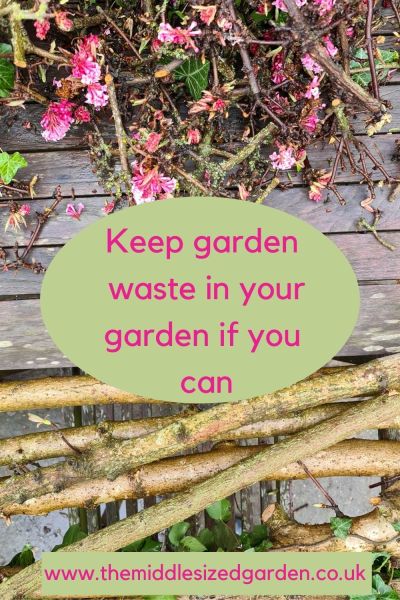
When you lay the compost on the borders, you’re returning the nutrients to the soil. You’ll save money because you’ll need to buy less mulch or fertiliser. And you’ll save time because you’re not taking garden waste to the recycling centre.
And there are other ways of keeping your garden waste in your garden. Sally also suggests making a log pile, constructing a ‘fedge’ or dead hedge and using clippings, such as lawn clippings directly as mulch.
‘A shredder is your friend,’ she says. When you shred garden clippings, they will compost down faster. And you can also add shredded clippings directly over your soil as mulch. It’ll keep the light away from weed seeds and will slowly break down to add nutrients to the soil.
There are instructions for all these in How to Garden the Low Carbon way. Essentially a fedge or dead head is a boundary made of felled branches, woody garden clippings and bracken, which very slowly decompose. Fedges offer a wonderful habitat for many kinds of wildlife.
Fedge or dead hedge in the Abbey Physic Garden Faversham, a community garden which follows eco-friendly and wildlife friendly policies.
If you can’t compost, then using a council green waste bin or taking clippings to the recycling centre is a good second-best.
What about eco-friendly garden design?
Sally has lots of eco-friendly garden design ideas in How to Garden the Low Carbon Way. These include buying second-hand sheds, greenhouses and paving stones. There are ideas for making paths, paving and patios more environmentally friendly without replacing them.
One of the best sustainable garden tips is to make the most of what you’ve already got, rather than ripping it out and starting new.

This greenhouse is made from recycled windows and shower doors. See more tips from this garden in Garden Inspiration from a medium-sized garden.
Recycling and upcycling is also eco-friendly, as well as saving you money. There are 15 ideas for recycling and upcycling for your garden here.
The garden shows this year featured several gardens based on recycling and upcycling. Find more contemporary ideas, many based on recycling here from RHS Hampton Court and here from BBC Gardeners World Live.
See more eco friendly garden design tips in this video:
You can see the interview with Sally in this video (plus some bonus eco-friendly garden design tips at the end.)
And for more sustainable gardening tips, see How to Create an Easy Sustainable Garden.
And if you’re just not sure that you can make much of a difference in your own little patch, see 15 questions about guilt-free ‘green’ gardening for some answers.
More about How to Garden The Low Carbon Way
The book is a very practical and realistic guide to making your garden environmentally friendly. Sally has drawn on scientific research and it’s also the way she herself gardens, so she knows the tips work.
How to Garden the Low Carbon Way includes tips on setting up your garden in an eco-friendly way, how to be wildlife friendly, and how to buy eco-friendly tools, plants and fertilisers in the most sustainable way.
I’ve added it to my list of Favourite Sustainable Garden Products on the Middlesized Garden Amazon store. You can also buy it from the RHS and there are other buying options on DK Books’ website.
You can find Sally Nex on Twitter and Instagram.
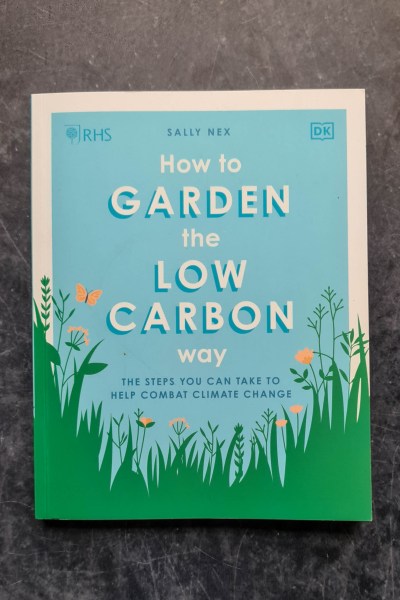
The RHS How to Garden the Low Carbon Way by Sally Nex, published by DK Books.
Pin to remember eco friendly garden tips
And do join us for our once-a-week blog posts. See here to get more free garden tips, ideas and inspiration directly to your email inbox.
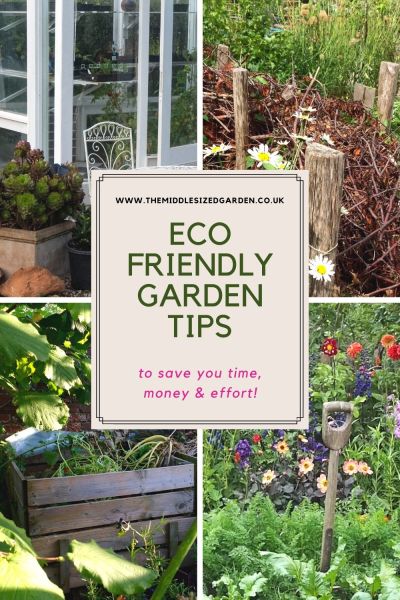
























I really liked your comment on grass clippings, I will be composting my clipping from now on.
I have been looking for ways to become more eco-friendly, glad I found your article. Great tips and thanks for sharing.
I bought a push mower two years ago and I love it! It provides exercise for me; it’s quieter for my neighbours and obviously uses up no fuel; it’s much lighter than the ones from the 1960s etc and it wasn’t that expensive. I leave the cut-off grass on the lawn. It helps that my lawn is fairly flat so I manage the cutting myself though I’m in mid-60s. You can use it on wet grass ….
I could go on, but I won’t!
I should have mentioned the push mower, because it is very environmentally friendly! Rather labour intensive over larger areas, but good exercise, so thank you.
Look forward to regular hints, tips, advice and inspiration.
Thank you!